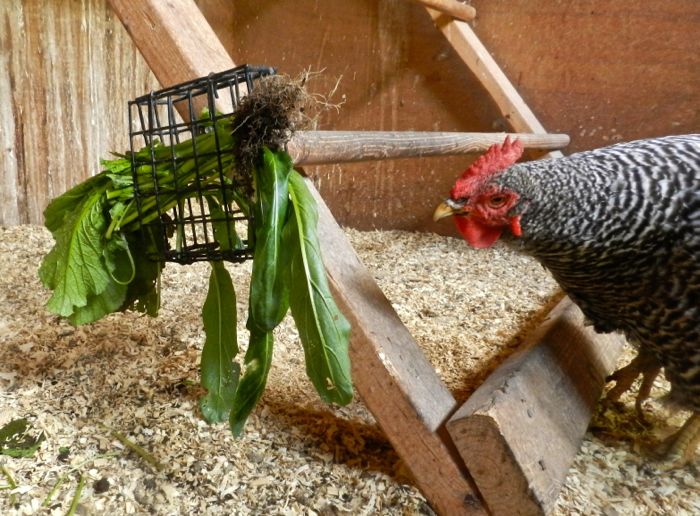We all love to give our hens treats. Unlike so many others in our lives, chickens are raucously grateful for the smallest offerings. But, I’ve seen a disturbing trend to over-indulgence in the feeding of backyard hens. You can make your chicken sick – or even kill her – with too many of the wrong treats.
Optimally, a chicken’s diet should be around 16% protein., which is what you get in laying hen pellets. A hen, cranking out an egg day after day, depletes her system of protein and minerals. If you feed her too many carbohydrates you’ll make her fat and weaken what goes on in the reproductive tract. So, as much as your girls are gleeful about cracked corn, don’t feed it. There’s absolutely no reason to. One of the bonuses of keeping chickens is that they turn kitchen scraps and waste into compost. You don’t have to give up on feeding stale bread and leftover spaghetti, but keep it a small portion of their diet.
On the other end of the spectrum, I am especially concerned about all of the people feeding their hens mealworms. A small amount, like a tablespoon a day, is a fine treat. But, people are feeding handfuls. They’re practically feeding their hens pure protein (mealworms are up around 50%) The chicken expert at my local feedstore just told me about hens dying from kidney failure due to being fed mealworms as the main part of their diet. Besides the health dangers, mealworms are very expensive. Yes, it’s good for chickens to eat bugs, bugs they have worked for and found themselves. Bugs that are part of an active life, and one in which the insects are part of other things that the chickens are sorting through and ingesting.
Hulled sunflower seeds are a nice treat – in moderation. They have that extra bit of protein, and also contain good essential fats. My retired girls get about a teaspoon per bird per day. Plenty! Don’t feed the seeds with the shells on, as too many can cause an impacted crop. The sunflower seeds are what I use to call my hens. If you’ve seen my YouTube video, you know how fast my hens come when called. Since they rarely get such treats, when they hear that can shake, they know something very, very special is waiting for them.
But all of this doesn’t mean that you can’t spoil your hens. For chickens like mine that spend the good part of their days in runs, the best thing that you can do is to provide greens. You can simply put weeds and things in their compost pile (I have mine in the run.) Or, to make the greens last and keep them up off of the ground, use a bird suet feeder.
This one is nailed to the roost in the Little Barn. I also have a larger one, than hangs from a chain. It’s big enough to put apple halves and cucumbers in.
Hanging treats like this keeps the greens fresh and clean and keeps the hens busy. It’s the right way to indulge your birds.


All my chickens got was what ever they found when free roaming, left over food scraps, some mash and oyster shells for their gizzards. They would follow me around and go crazy for the bugs, worms etc when I rolled a rock or log over. They also loved cicadas when I could catch them. Terri do you give yours oyster shells or do they not need them now??
Yes, they get oyster shell free choice in a separate feeder.
Speaking of feed for chickens, Terri, I wrote to you a while ago about the local way of feeding chicks here – what looks like ground up pellets, recommended for all ages and stages. We declined! There was no analysis on the bag – absolutely none – so we are feeding good organic starter and our little girls are loving it. We are only feeding four birds, so the extra expense is small. Your suggestions for treats are most helpful!
Not all feed mills do a good job mixing up laying hen feed, as your example shows. It’s easy to hide poor-quality grains in pellets and ground-up feed. I’m pleased your hens are doing well on the good stuff!
I was wondering can you give hens as a treat those suets peanut block things that people put out for wild birds ? I would think that would give them a challenge to peck at as well. And they don’t seem to be so bad on the prices.
Lol I also was watching a video where a guy when he is out free ranging with the hens, that they will go after the bird feeders and raid them, even though they are up high, or his bantams will and they will chase off the wild birds who come to feed while they are their. Did you ever have that problem with your bantams Terry ?
The suet feed blocks are mostly fat. I wouldn’t feed that to my hens. BTW, you can find flock blocks in feed stores, and although they can keep hens busy, they are also too high in fat, and I’d worry about attracting mice and wild birds.
A small pot of plain live yoghurt very occasionally for the elderly hen is good too – keeps things nice and acidic if crop transit is slow and prevents sour crop developing. Also useful for tempting a recovering bird to eat, especially with a couple of raisins to aim at to get that first mouthful of yoghurt into them. Then there’s generally no stopping them!
I’d be mugged and left for dead if I went into the orchard with a bag of sunflower seeds…
Good point on the yogurt. “Occasionally” being the key – I’ve heard from people who were feeding bowls of it daily! While you were here I should have had you try to feed my girls raisins. They won’t touch them. Nor will they eat dried currants. You should see the looks they glare at me if I try.
Very odd, about the raisins. I find sultanas to be particularly useful for getting medicine down a hen. A Baytril tablet or a single dose of metacam fits nicely inside and once offered it’s down the throat before they realise you’ve tricked them.
And as for suet balls, I’m with you on the fat content; but a bird-loving friend had one left over from a big sack and so she hung it up for her chickens. One took a peck and set it swinging, and then they all started weaving around in time with its movement like cobras watching the end of a snake-charmer’s pipe. I laughed ’til I cried. None of the others pecked at it, they were just mesmerised. It was removed when we had regained enough strength to walk, and hung in the tree for the robins.
LOL! That is HILarious about the hens weaving around the swining suet balls like cobras!
I have bamboo and if you are familiar with it it can take over and “repoduces” via runners. I simply cut the young shoots at ground level and then hang from the hens ladder day roost in their runs. Keeps them busy a very long time pulling all the green off.
Bamboo! How clever. I’m afraid that if I plant it that it’ll go invasive here. I wonder what the goats would think of it?
I warn anyone who it considering it to be careful. I can be very evasive. I friend gave me a couple starts years ago. I planted them in the run and fenced off of course. It has now turned into a 12 foot tall by 12 feet long sun screen for the hens. They have 360 complete access around it so they eat the tender shoots as they emerge in the run. It does emerge outside the run and those are the ones I cut at about three feet and hang for the hens.
This planting turned out to be a excellent move on my part. The tornado of last year relandscaped my yard and left me without one tree in the back. So in the afternoon it provides plenty and the only shade.
My hens clean up lots of unshelled sunflower seeds from our (wild) bird feeders. I will move the feeders to minumize the hens exposure. What are the symptoms of compacted crop and is there a treatment for it?
An impacted crop gets large and hard as a baseball. Nothing can get through and the bird can actually die of starvation and thirst. Massage and small amounts of olive oil can help move things along.
Hi Terry! COMPLTELY off the subject….I was trying to find your recipe for what you do when you have an excess of tomatoes? I remember you sliced them and put them in the oven to use later for sauce? I am going to have a LOT of tomatoes this year and I want to be prepared! Thank you and LOVE the new site!
I’m hoping that I’ll have a bumper crop of tomatoes, too. Stay tuned for recipes and tips about how to freeze.
One of my pupils gives me half a dozen of fresh eggs from his own hens every now and then. I intended to buy a treat for these hens to thank them for their lovely eggs and was about to buy a jar of dried mealworms. After reading your blog I think this is not such a good idea. Do you have a suggestion for a better present, Terry?
What a nice gift to get from a student! Meal worms are good treats – just in moderation, like a teaspoon, not a handful. Hulled sunflower seeds are also good. Or a jar of popcorn for the pupil and the chickens to share.
Here’s a treat that’s not really a treat: I mix some of their pellets with a little warm water or a bit of yogurt. Even with plain water they go nuts for it. Same old pellets, but they like it better.
Mine stand at the back door when they hear me cooking in the kitchen. Tomato scraps are their favorite.
My girls LOVE cooked spaghetti (I imagine they think it’s a big pile of worms) and cooked rice! They also are quite fond of berries.
When it’s really cold for days on end I cook them up some oatmeal or malt o meal. Can you say “SPOILED”!!!!!!
They are so much FUN to watch and are always so grateful! I love them running up to me to see what yummy treat I have!
Thanks!
Lynn
Terry, I will be the first to admit I do, at times, indulge my girls. Flock Blocks I find beneficial on rainy or long cold winter days, a cup full of scratch in the afternoon seems to settle everyone in nicely. Greens and organic feed round out the girls diet. Thank you for this most informative post. Greetings, Julie.